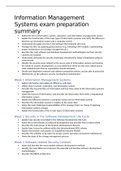Summary
Get your Information Management Systems Credits with this Summary
- Course
- Institution
- Book
Makri handouts used to write the summary. All learning goals per week have been verified and included in the summary, so all the material you need to know for the (re) exam is in this document, concise, but comprehensive!
[Show more]




